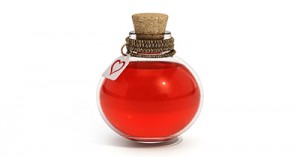Use household ingredients to create this cool lava lamp that glows in the dark!
Materials Needed:
- Vegetable oil
- Water
- Alka-Seltzer Tablets (antacid tablet)
- Plastic bottle/Jar
- 2 Glow sticks
What to do:
- Add 1 cup of vegetable oil into the bottle
- Add 2/3 cup water into the jar - wait until the water has settled to the bottom
- Crack and shake a glow stick to illuminate it.
- Cut the top of the glow stick (only to be done by adult)
- Pour the contents of the glow stick in to the jar (do not mix or stir it)
- Add the Alka-Seltzer table into the bottle.
- Watch what happens!
The Science Factor:
You will notice that the oil floats on top of the water. Oil and water don't mix. When you drop the antacid tablet into the top of the bottle it falls through the oil without any sort of reaction. When it hits the water, the acid and base powders that make up the tablet combine as they dissolve in the water and begin to release carbon dioxide gas bubbles. The gas rises and takes the contents of the glow stick along with it up through the oil layer. When this glob of water and bubbles reaches the top of the oil, the gas escapes. Without the gas to lift it, the water droplet falls back to the bottom of the bottle. This cycle will repeat until all of the antacid is used up. While this is happening you will also see the "glow" from the glow stick.
Hints and Tips:
- Keep adding Alka-Seltzer tablets as they dissolve.
- Instead of using Alka-Seltzer tablets, you can use salt. Fill a plastic container with water until it's 2/3 full, add food colouring, add 1/3 of vegetable oil (wait until it settles), shake salt into it and watch.
- If not using glow sticks - Put a large flash light or shine a torch under the bottle see what the lava lamp looks like with a light.
Note: This experiment required adult supervision at all times!







